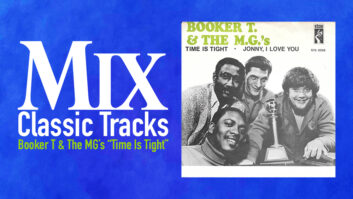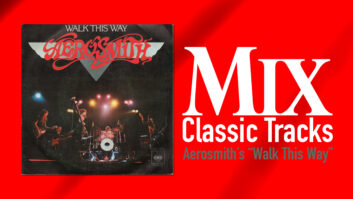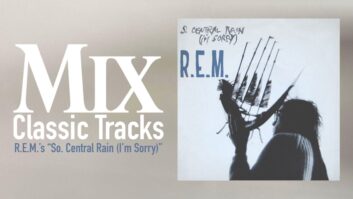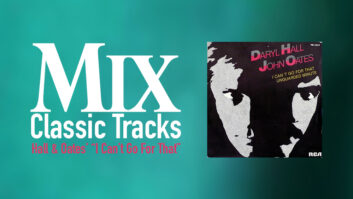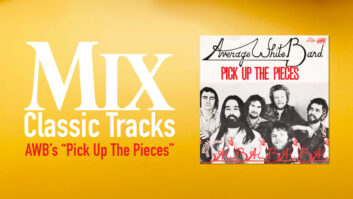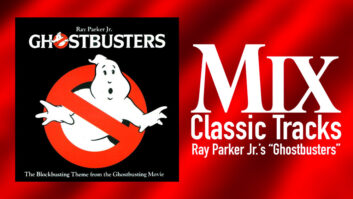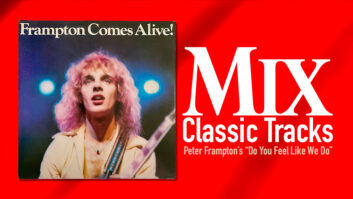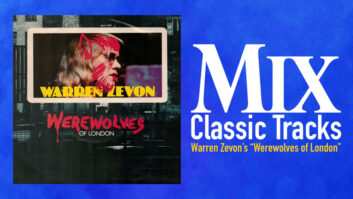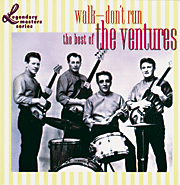

Buckle up, because this month we’re taking the Wayback Machine out for a real spin — all the way back to 1960. JFK became president that year, proclaiming, “The torch has been passed to a new generation of Americans, born in this century.” Elvis Presley returned home from a two-year Army stint in Germany, and Cassius Clay (soon to become Muhammad Ali) captured a gold medal at the summer Olympics in Rome. The Civil Rights movement was heating up and exposing the great racial and cultural divide that was splitting America. Fifteen years after the end of World War II, America was enjoying unparalleled prosperity, and the West Coast in particular was growing fast and beginning to influence the culture more and more.
Against this backdrop, a pair of young guitar players from the Seattle area, Don Wilson and Bob Bogle, walked into Boles Studio one day with a drummer and recorded their version of a Johnny Smith instrumental they’d heard on a Chet Atkins album called Hi-Fi in Focus. “Walk Don’t Run” became the song that launched The Ventures.
Bogle, who would relinquish first-chair duties to Nokie Edwards when Edwards joined the group several years later, played the melody line on “Walk Don’t Run.” “I played a lot of the leads at first,” says Bogle, “and then moved over to the bass when Nokie joined the band. I never did try to copy anyone else’s style because I wasn’t that good! I had no choice but to develop my own style; Les Paul and Chet Atkins were way over my head. In fact, I hadn’t been playing for long before we recorded ‘Walk Don’t Run’!”

Read more “Classic Tracks”
Buy the book
Although they prefer to be labeled a rock band, both Bogle and Wilson acknowledge their contribution to the “surf-rock” genre, and still cover many surf hits (including “Wipeout” and “Pipeline”) in their live shows. A shower of reverb, emanating from the spring units of the Fender amplifiers they favored, and a heavy emphasis on the vibrato bar marked their sound. “I loved the whammy bar!” Bogle enthuses. “Everything sounded better when you leaned on that, I thought — and still do! We use it on the majority of leads, even today.”
Often overlooked is the precise intonation that is a characteristic of Ventures’ records. This was no small feat in 1960, when the technology that players rely on today to leave the guitar in tune when the whammy bar is used had not been developed. “That’s right,” Bogle says. “We paid strict attention to tuning, and we knew that lots of records were released with poor guitar intonation.”
Wilson played rhythm guitar on “Walk Don’t Run” and has held that position in The Ventures ever since. A state champion wrestler in his high school days, Wilson brought an athletic approach to his instrument that helped define the group’s sound. “When Bob and I first started, there were only the two of us,” says Wilson. “Eventually, we got a drummer and bass player, but at that time we didn’t know any! Bob played full chords behind some of the notes in his leads, and I tried to make up for the lack of drums by playing very percussively. My approach to playing rhythm guitar was unique, I suppose, in that I really hit hard. I play lots of double rhythms that sound like drum rolls.”
Speaking of rhythm and the cultural divide that existed at the time, it must be pointed out that an absence of swing is a critical component of The Ventures’ guitar sound. They articulate as precisely as the Philadelphia Orchestra would when playing a Mozart symphony: Eighth notes are always two equal divisions of the quarter. “No matter what we play, we ‘Venturize’ it,” says Bogle. “It’s certainly fair to say that our music is not R&B. Everything we do has an aggressive, driving sound, but it’s not the kind of aggression you hear with rock groups that feature a distorted guitar.”
The Ventures decided to record “Walk Don’t Run” at Boles Studio, one of the most respected in the area. Wilson’s mother, Josie, who passed away recently, was a pivotal force in the history of The Ventures. She financed “Walk Don’t Run,” helped market it and gave the group its name; originally, Bogle and Wilson had called themselves The Versatones.
“Joe Boles used a 2-track Ampex recorder,” Wilson recalls. “He was a very good engineer who had recorded a couple of Number One hits — ‘Come Softly to Me’ and ‘Mr. Blue’ — for The Fleetwoods. Joe always used a tape-based delay effect. When you’re using a 2-track tape player without a board, there’s a lot less going on in the recording process, but Joe had plenty of tricks up his sleeve. He’d even mike the pick sound when you were playing! We were so impressed with him that we recorded our first two LPs there.
“There weren’t many decisions to be made in the mix; whatever effects Joe would put on the guitars and drums were added during the recording process,” Wilson continues. “The bass and drums were on one track, the rhythm and lead on the other. We did have a lot of input on the sound of the record. In particular, I remember us asking for lots of reverb on the lead guitar.” No one involved remembers what mics might have been used on those sessions.
Despite that, the initial session remains vivid for Bogle. “At the time, I had recently purchased a Fender Jazzmaster guitar [the group’s identity would in part be shaped by the Mosrite guitars they later came to play], which I played through a Fender Dual Showman amplifier. In those days, there were no punch-ins; you kept playing the entire song until you got it right. I seem to remember us laying down about a half-dozen takes of ‘Walk Don’t Run.’
“The mastering process sticks in my mind. The final mix was sent down to Hollywood to be mastered by an engineer named Bunny Robine at United Recorders. ‘Walk Don’t Run’ was mixed in stereo, but it also had to be mixed down to mono because there were very few stereo record players in 1960. Bunny’s initial mix was too trebly for our taste and so he fixed it nicely for us.”
After being picked up by Dolton Records, “Walk Don’t Run” quickly climbed the charts and peaked in Billboard‘s Number 2 slot, behind Presley’s “It’s Now or Never.” With a lineup that included Edwards and drummer Howie Johnson, the group turned out a number of albums in the early ’60s and enjoyed a second round of commercial success with the song when they tracked “Walk Don’t Run ’64.” In 1963, Johnson was injured in a car crash and Mel Taylor joined the group. Taylor remained the group’s drummer until his death in 1996, at which time his son, Leon, assumed those duties.
Surf groups became déclassé during the cultural revolution that swept through America in the late 1960s, and The Ventures, who continued to record, found it hard to remain in the forefront. Until 1969, that is, when their cover of the theme to the popular television show Hawaii Five-0 vaulted the group back into the limelight. It would be their last commercially successful recording in the United States. In all, though, they put out 37 charting albums between 1960 and 1972, and landed 14 instrumentals on the Billboard Hot 100 singles chart.
Over the years, The Ventures have become one of the most popular recording groups in Japan, amassing, as of 2007, a total of 20 Number One recordings there. In addition to the players mentioned, guitarists Gerry McGee and Bob Spaulding have lent their talents to the group on a regular basis for more than two decades. To date, The Ventures have sold more than 110 million albums and enjoy the distinction of being the best-selling instrumental rock group in history.

LISTEN: Must Play
Walk Don’t Run
